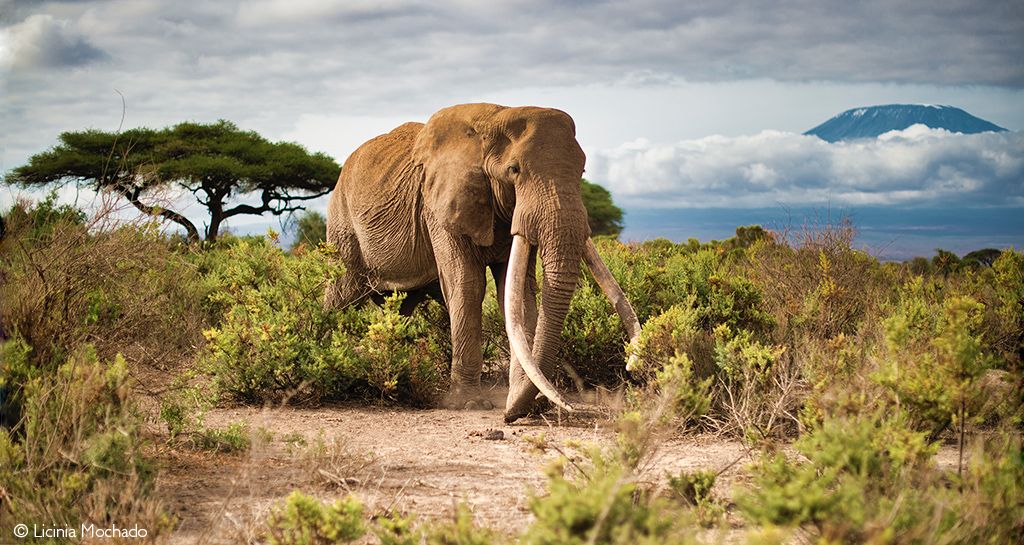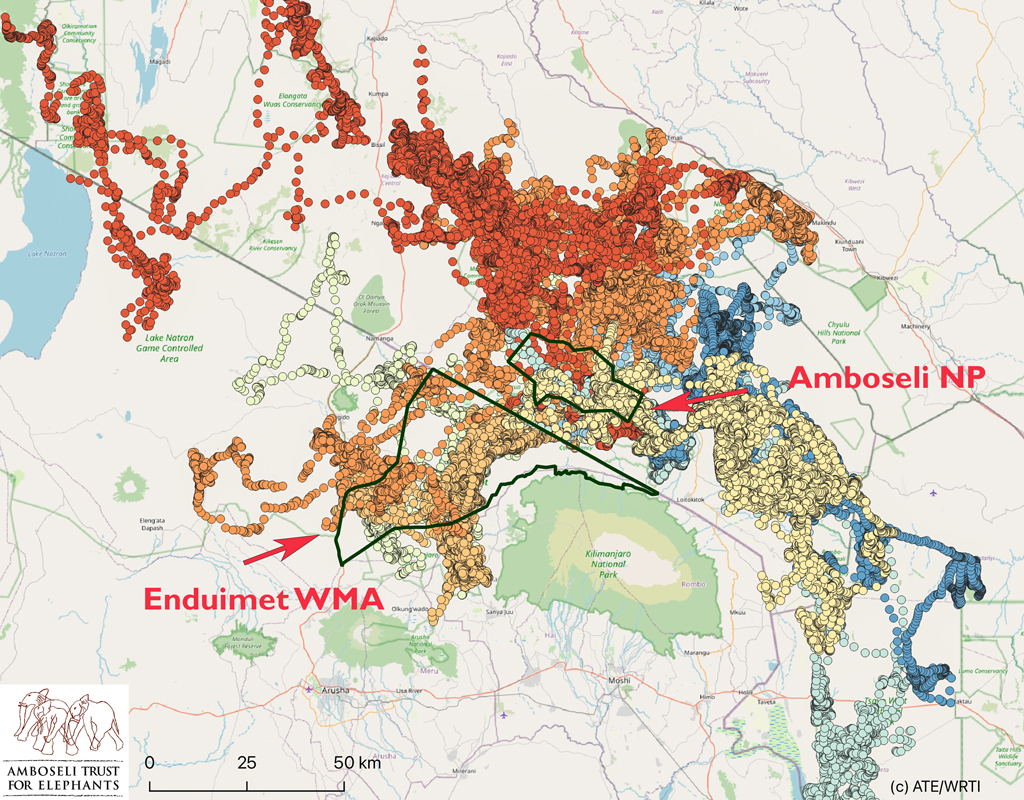A third elephant hunted last week in the Enduimet area of Tanzania, within 40km of the Kenya/Tanzania border, has amplified the debate around hunting free-roaming cross-border elephant populations and super tuskers and driven a wedge between segments of the hunting community. With another three hunting licenses granted for elephant hunts in this region in the coming months, the integrity of the Amboseli elephant population is in jeopardy.
Update 14/03/2024: Amboseli Trust for Elephants has positively identified the first trophy-hunted bull as Gilgil, a breeding elephant aged 35, who would have been approaching his prime reproductive years. Male elephants reach their prime breeding years at or about 40 years. Our sources confirm Gilgil was a ‘100-pounder’, with one tusk weighing 99 pounds and the other 110 pounds – though photos recently shared of Gilgil are dated and do not reflect his tusk size at the time he was killed.
Following these legal hunts, about 10 super tuskers are left in the Amboseli Ecosystem, according to Big Life Foundation. This ecosystem encompasses land on either side of the Tanzania/Kenya border, including Amboseli National Park and surrounding conservancies in Kenya, as well as the Enduimet Wildlife Management Area and beyond in Tanzania.
The Amboseli elephant population includes well-known super tuskers (elephants with one or both tusks weighing over 100-pounds) such as Craig, Esau, Tee-Jay, Michael and One Ton – famous super tuskers that attract thousands of tourists yearly. Hunting is illegal in Kenya, but these elephants are vulnerable to trophy hunting when crossing into Tanzania, where hunting elephants with a license is legal.
 Super tusker Craig in Amboseli National Park
Super tusker Craig in Amboseli National Park
In January, Africa Geographic broke the news that two super tuskers were hunted in the Enduimet area, close to the Kenyan border, in the latter half of 2023, sparking division within the hunting community and outrage outside of it. On 1 March this year, Africa Geographic received unconfirmed reports that a third elephant had been hunted in the Enduimet region. Shortly after this, news of the hunt started circulating on social media. On 11 March, Big Life Foundation released a statement confirming that a third elephant had been hunted. The statement noted that the elephant’s carcass was also burnt (as with the first two hunts), making identifying the specific elephant impossible. The tusk size of the third hunted elephant is unknown.
Elephant Voices, Big Life Foundation and Amboseli Trust for Elephants have released a Joint Statement on the Amboseli Elephants calling for the protection of this cross-border population and raising concerns about the granting of three further elephant-hunting licenses. These organisations are calling for the reinstatement of a moratorium on hunting in the border region, which has been in place since 1995:
“Our position is that the Amboseli cross-border population should be protected from trophy hunting because it is unique and highly valuable as a scientific base of knowledge of elephants. In addition, it represents one of the last gene pools for large tusks. A successful moratorium held for 30 years.… We appeal to the Tanzanian and Kenyan governments to work together to protect this cross-border population, to recognise its immense scientific value and to ensure that these treasured elephants are not the target of trophy hunters.”
All 2,000 elephants in the Amboseli elephant population are known, as they have been closely studied by the Amboseli Elephant Research Project (AERP) for 51 years.
“There are 63 elephant families in the Amboseli population, of which 17 families, consisting of 365 members, regularly spend time in Tanzania. In addition, approximately 30 adult male elephants, over the age of 25 years, use the Enduimet area and beyond in Tanzania as part of their home range,” says the Joint Statement. “For half a century, Enduimet has been a favourite area for a particular set of adult males who use it as part of their ‘bull area’, which is an area they use when they are bulking up for their next reproductively active period.”
 A map illustrating AERP’s recent (2019 to present) tracking results of eight young males from known Amboseli families. It is reasonable to assume that any elephant found in this area of Tanzania is part of the cross-border population and has been captured by AERP’s long-term study. © Amboseli Trust for Elephants
A map illustrating AERP’s recent (2019 to present) tracking results of eight young males from known Amboseli families. It is reasonable to assume that any elephant found in this area of Tanzania is part of the cross-border population and has been captured by AERP’s long-term study. © Amboseli Trust for Elephants
Other stakeholders are also pushing for Tanzania to reinstate the cross-border agreement with Kenya to protect these elephants, with a petition on Change.org calling for signatures.
“Male elephants grow throughout their lifetime, as do their tusks.… By selecting older individuals, hunters not only have a damaging effect on elephant lives and society, but are negatively influencing the genetic future of the Amboseli population, not to mention the ecosystem’s tourism potential,” says the Joint Statement. Big Life added in their own statement, that “old bulls are not past their reproductive prime, as hunters contend. Research has shown that elephant bulls only reproduce consistently by age 40, by which time 75% of them will have died. So older bulls are in fact disproportionately important for breeding.”
 Putting elephants on the map – exploring connectivity in southern Africa
Putting elephants on the map – exploring connectivity in southern Africa
Meanwhile, the African Professional Hunters Association has warned its members not to share photos on social media of hunted species that will “inflame public opinion”, and not to “deliberately market” any areas as “bordering non-hunting areas”. “The reality is that there are certain elephant bulls that we simply must avoid a confrontation with.… As to ignore such could come at grave cost to the entire act of elephant hunting,” reads the letter to members.
Since the killing of the third elephant, Africa Geographic has consulted with sources close to the hunt. While confirming that an elephant was shot in Enduimet, most sources refused to be named or provide documentation for fear of their safety. However, speculation on the identity of the hunting company and hunters involved is rife, with one prominent Texan hunter openly posting details of daily hunting activities in Enduimet on social media during the same period that the third elephant was shot. In the days following the killing of the elephant, he made his Instagram account private and has been inactive since. According to Instagram posts from the hunting party, the individuals were operating on a 21-day hunting license and killed at least 19 other animals during this period, including spotted hyenas, Patterson’s eland, Grant’s gazelle, gerenuk, Kirk’s dik-dik, lesser kudu, as well as wildebeest and zebra for “bait for a cat hunt”.
Various statements from within the trophy hunting industry, including the statement by Tanzanian spokesperson Michel Mantheakis addressed to Africa Geographic, indicate that there is a rising trend amongst a small faction of the industry for concealing these hunts targeting super tuskers rather than moving away from hunting them.
We will provide more information as it arises.











